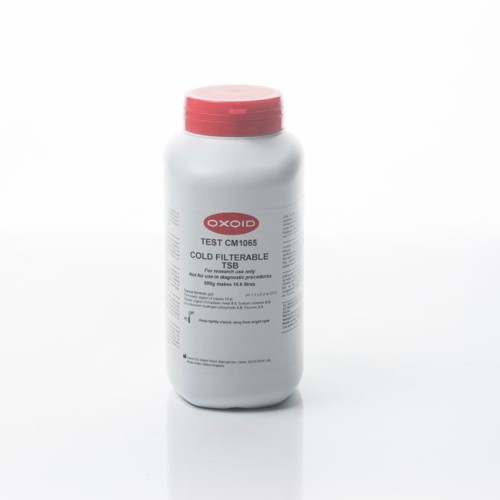
MRS (ISO) Agar 500g
Login to see pricesBrand:
Thermo ScientificTM OxoidTM
Isolate and enumerate lactic acid bacteria from food with Thermo Scientific™ Oxoid™ MRS (ISO) Agar (DeMan, Rogosa and Sharpe) (Dehydrated) while adhering to ISO 15214: 1998. This medium is designed to support the growth of all strains of Lactobacilli, even the difficult and slow-growing strains of Lactobacillus brevis and Lactobacillus fermenti.
MRS (ISO) Agar (DeMan, Rogosa and Sharpe), Oxoid Composition
| Typical Formula * |
gm/litre
|
| Enzymatic digest of casein |
10 |
| Meat extract |
10 |
| Yeast extract |
4 |
| Tri-ammonium citrate |
2 |
| Sodium acetate |
5 |
| Magnesium sulphate heptahydrate |
0.2 |
| Manganese sulphate tetrahydrate |
0.05 |
| Di-potassium hydrogen phosphate |
2 |
| Sorbitan mono-oleate |
1.08 |
| Glucose |
20 |
| Agar |
12.4 |
| TOTAL | 66.73g/L |
MRS (ISO) Agar (DeMan, Rogosa and Sharpe), Oxoid Preparation:
Suspend 66.73g in 1 litre of distilled water. Boil to dissolve the medium completely. Dispense into tubes, bottles or flasks and sterilize by autoclaving at 121°C for 15 minutes. Selectivity can be altered by pH adjustment.
Storage conditions and Shelf life
Store the dehydrated medium at 10–30°C and use before the expiry date on the label.
Store the prepared plates at 2–8°C.
Precautions
Sterilization of this medium in some autoclaves, at 121°C for 15 minutes, may cause the medium in some cases to fall outside the specified pH limit of 5.7 ± 0.1. Adjustment of the medium in these rare cases is recommended using acetic acid or sodium hydroxide.

Pre-Supplemented DG18 (ISO) Agar
Login to see pricesBrand:
Thermo ScientificTM OxoidTM
Isolate and enumerate yeasts and molds associated with food spoilage with Thermo Scientific™ Oxoid™ Pre-supplemented Dichloran-Glycerol 18% (DG18) (ISO) Agar Base (Dehydrated) while adhering to BS ISO 21527-2: 2008. Due to the presence of antibiotic Chloramphenicol in the formulation, the medium provides selectivity against bacteria as well as reducing harmful chemical handling in the laboratory.
Pre-supplemented Dichloran-Glycerol 18% (DG18) (ISO) Agar Base (Dehydrated), Oxoid Composition
| Typical Formula* |
gm/litre |
| Casein Enzymatic digest |
5.0 |
| Glucose |
10.0 |
| Potassium dihydrogen phosphate |
1.0 |
| Magnesium sulphate |
0.5 |
| Dichloran (2,6-dichloro-4-nitroaniline) |
0.002 |
| Agar |
15 |
| Chloramphenicol | 0.1 |
| pH 5.6 ± 0.2 @ 25°C |
Pre-supplemented Dichloran-Glycerol 18% (DG18) (ISO) Agar Base, Oxoid Preparation:
Suspend 15.8g per 500ml (31.6g/l) of distilled water and heat to dissolve completely. Before autoclaving add 220g of Glycerol per 1 litre of medium. Heat the complete solution gently to aid its dissolution of the glycerol. This has been found to be a key procedure to follow to allow proper dissolution of the glycerol. Sterilize by autoclaving at 121°C for 15 minutes. Cool to 50°C, mix well and pour into sterile Petri dishes.
Where bacterial overgrowth occurs from certain foods (raw meats) chlortetracycline hydrochloride at 50mg/L (dissolved in water and filter sterilised) is recommended.
Storage instructions
Store the dehydrated medium at 10–30°C and use before the expiry date.
Precautions
The dichloran compound used in this medium is Botran® 2,6-Dichloro-4-Nitro-Analine (CAS: 99-30-9).
Pre-supplemented DG18 (ISO) Agar (CM1151) contains Chloramphenicol in the base powder and is therefore considered a toxic compound which should be handled in accordance with good industrial hygiene and safety practice. Always consult the MSDS before handling the powder.

Pre-Supplemented DRBC (ISO) Agar
Login to see pricesBrand:
Thermo ScientificTM OxoidTM
Isolate and enumerate yeasts and molds associated with food spoilage with Thermo Scientific™ Oxoid™ Pre-supplemented Dichloran Rose-Bengal Chloramphenicol (DRBC) (ISO) Agar Base (Dehydrated) while adhering to ISO 21527-1: 2008. Due to the presence of antibiotic Chloramphenicol in the formulation, the medium provides selectivity against bacteria as well as reducing harmful chemical handling in the laboratory.
Pre-supplemented Dichloran Rose-Bengal Chloramphenicol (DRBC) (ISO) Agar Base (Dehydrated), Oxoid Composition
| Typical Formula* |
gm/litre |
| Peptone |
5.0 |
| Glucose |
10.0 |
| Potassium dihydrogen phosphate |
1.0 |
| Magnesium sulphate |
0.5 |
| Dichloran |
0.002 |
| Rose-bengal |
0.025 |
| Agar |
15.0 |
| Chloramphenicol |
0.1 |
| pH 5.6 ± 0.2 @ 25°C |
Pre-supplemented Dichloran Rose-Bengal Chloramphenicol (DRBC) (ISO) Agar, Oxoid Preparation:
Suspend 15.75g per 500ml (31.5g/l) of distilled water and heat to dissolve completely. Sterilize by autoclaving at 121°C for 15 minutes. Cool to 50°C, mix well and pour into sterile Petri dishes. It is advised to dispense the powdered medium into containers under an extraction hood due to the chloramphenicol in the medium base.
Storage instructions
Store the dehydrated medium at 10–30°C and use before the expiry date
Precautions
ROSE-BENGAL PHOTO-OXIDIZES TO FORM TOXIC COMPOUNDS. STORE PLATES OF THE MEDIUM IN THE DARK AND AVOID EXPOSURE TO LIGHT.
Some strains of fungi may be inhibited on this medium.
The dichloran compound used in this medium is Botran® 2,6-Dichloro-4-Nitro-Analine (CAS: 99-30-9).
Pre-supplemented DRBC (ISO) Agar (CM1149) contains Chloramphenicol in the base powder and is therefore considered a toxic compound which should be handled in accordance with good industrial hygiene and safety practice. Always consult the MSDS before handling the powder.
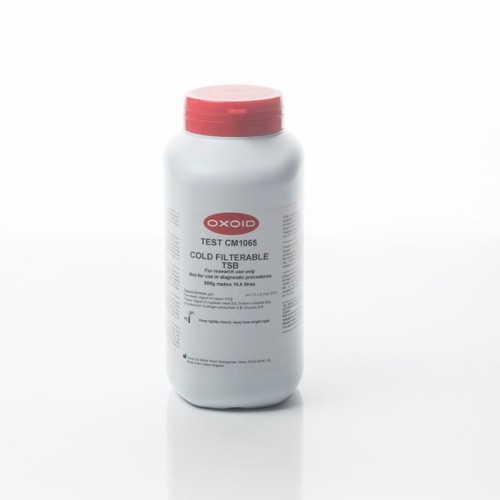
DRBC (ISO) Agar Base 500g
Login to see pricesBrand:
Thermo ScientificTM OxoidTM
Isolate and enumerate yeasts and molds associated with food spoilage with Thermo Scientific™ Oxoid™ Dichloran Rose-Bengal Chloramphenicol (DRBC) (ISO) Agar Base while adhering to ISO 21527-1: 2008. Dichloran Rose-Bengal Chloramphenicol (DRBC) (ISO) Agar is specially designed to suppress the growth of spreading mold and bacteria while supporting the growth of species that cannot be isolated on Rose Bengal Chloramphenicol Agar or Acidified Potato Dextrose Agar.
Dichloran Rose-Bengal Chloramphenicol (DRBC) (ISO) Agar, Oxoid Composition
| Typical Formula* | gm/litre |
| Peptone | 5.0 |
| Glucose | 10.0 |
| Potassium dihydrogen phosphate | 1.0 |
| Magnesium sulphate | 0.5 |
| Dichloran | 0.002 |
| Rose-bengal | 0.025 |
| Agar | 15.0 |
| pH 5.6 ± 0.2 @ 25°C |
Dichloran Rose-Bengal Chloramphenicol (DRBC) (ISO) Agar, Oxoid Preparation:
Suspend 15.75g per 500ml (31.5g/l) of distilled water and heat to dissolve completely. Reconstitute Chloramphenicol Supplement (one vial SR0078E per 500ml or one vial SR0078H per 2 litres medium), as directed. Add the vial contents to the DRBC (ISO) Agar Base. Sterilize by autoclaving at 121°C for 15 minutes. Cool to 50°C, mix well and pour into sterile Petri dishes.
Storage conditions and Shelf life
Store the dehydrated medium at 10–30°C and use before the expiry date.
Precautions
ROSE-BENGAL PHOTO-OXIDIZES TO FORM TOXIC COMPOUNDS. STORE PLATES OF THE MEDIUM IN THE DARK AND AVOID EXPOSURE TO LIGHT.
Some strains of fungi may be inhibited on this medium.
The dichloran compound used in this medium is Botran® 2,6-Dichloro-4-Nitro-Analine (CAS: 99-30-9).
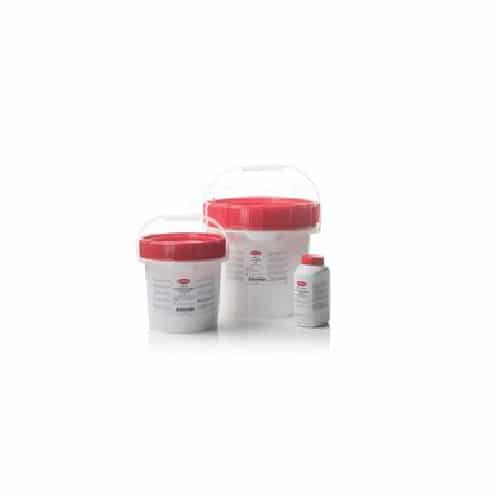
Brain Heart Infusion Agar 500g
Login to see pricesBrand:
Thermo ScientificTM OxoidTM
Cultivate fastidious organisms with highly nutritious Thermo Scientific™ Oxoid™ Brain Heart Infusion Agar (Dehydrated). Brain Heart Infusion Agar is recommended for the cultivation of Streptococci, Neisseria and other fastidious organisms.
Brain Heart Infusion Agar, Oxoid Composition
| Formula |
gm/litre |
| Brain infusion solids |
12.5 |
| Beef heart infusion solids |
5.0 |
| Proteose peptone |
10.0 |
| Sodium chloride |
5.0 |
| Glucose |
2.0 |
| Disodium phosphate |
2.5 |
| Agar |
10.0 |
| pH 7.4 ± 0.2 @ 25°C |
Brain Heart Infusion Agar, Oxoid Preparation:
Suspend 47g in 1 litre of distilled water. Bring to the boil to dissolve completely. Sterilize by autoclaving at 121°C for 15 minutes. Mix well and pour into sterile Petri dishes. For blood agar, cool to 50°C and enrich with 10% v/v sterile defibrinated blood.
Storage conditions and Shelf life
Store the dehydrated medium at 10-30°C and use before the expiry date on the label.
Store the prepared plates of medium at 2-8°C.
Precautions
The medium is tested for compatibility using 7% v/v oxalated horse blood, defibrinated horse blood or defibrinated sheep blood. There should be no evidence of lysis or darkening after incubation at 37°C, 25°C or 4°C for 72 hours.
When using this medium to isolate Histoplasma capsulatum, Coccidioides immitis or other pathogenic fungi which can produce free infective spores, extreme care must be taken to avoid dissemination of infective particles in the laboratory. The cultures should be examined only in a closed, filtered air cabinet.
This medium is unsuitable for the screening of vancomycin resistant enterococci (VRE). More suitable and superior media for the screening of VRE are available; Brilliance VRE PO1226A or Remel BHI with Vancomycin RO1176.
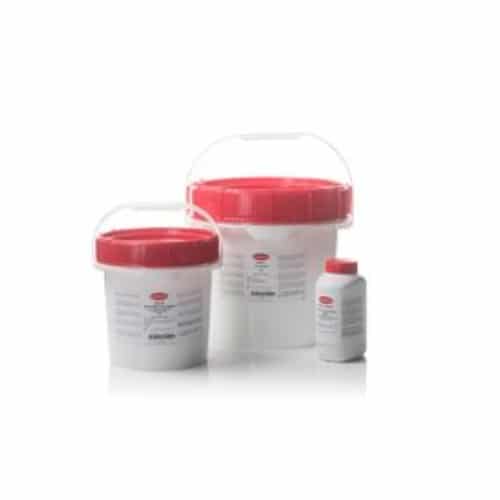
Brain Heart Infusion Broth 500g
Login to see pricesBrand:
Thermo ScientificTM OxoidTM
Cultivate streptococci, Neisseria and other fastidious organisms with Thermo Scientific™ Oxoid™ Brain Infusion Broth (Dehydrated). The medium is highly nutritious and well buffered to support the growth of wide variety of organisms. It is recommended for blood culture work for the isolation and cultivation of pathogenic fungi.
Brain Infusion Broth, Oxoid Composition
| Formula |
gm/litre |
| Brain infusion solids |
12.5 |
| Beef heart infusion solids |
5.0 |
| Proteose peptone |
10.0 |
| Glucose |
2.0 |
| Sodium chloride |
5.0 |
| Disodium phosphate |
2.5 |
| pH 7.4 ± 0.2 @ 25°C |
Brain Infusion Broth, Oxoid Preparation:
Dissolve 37g in 1 litre of distilled water. Mix well and distribute into final containers. Sterilize by autoclaving at 121°C for 15 minutes.
Storage conditions and Shelf life
Store the dehydrated medium at 10-30°C and use before the expiry date on the label.
Store tubed or bottled medium in the dark and below 20°C.
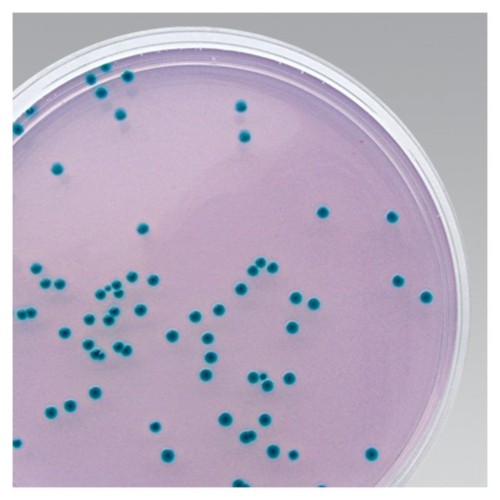
E.Sak Isolation Agar Base 500g
Login to see pricesBrand:
Thermo ScientificTM OxoidTM
Oxoid Cronobacter Sakazakii Isolation Agar (ISO) is a chromogenic medium for enrichment and isolation of Cronobacter spp. from milk and milk products in compliance with ISO/TS 22964: 2006.
E.Sak Isolation Agar Base, Oxoid Composition
| Typical Formula* |
gm/litre |
| Pancreatic digest of casein† |
7.0 |
| Yeast extract |
3.0 |
| Sodium chloride |
5.0 |
| Sodium deoxycholate†† |
0.6 |
| 5-Bromo-4-chloro-3-indolyl α-D-glucopyranoside |
0.15 |
| Crystal violet |
0.002 |
| Agar |
12.0 |
| pH 7.0 ± 0.2 @ 25°C |
E.Sak Isolation Agar, Oxoid Preparation:
Suspend 27.75g in 1 litre of distilled water. Bring to the boil to dissolve completely. Sterilize by autoclaving at 121°C for 15 minutes. Cool to approximately 50°C. Mix well and pour into sterile Petri dishes.
Storage conditions and Shelf life
Store the dehydrated medium at 10-30°C and use before the expiry date on the label.
The prepared medium is best used freshly prepared, but may be suitable for longer storage following in-house validation.

Modified Lauryl Sulphate Tryptose Broth
Login to see pricesBrand:
Thermo ScientificTM OxoidTM
Selectively enrich Cronobacter spp. from milk and milk samples using Thermo Scientific™ Oxoid™ Modified Lauryl Sulphate Tryptose Broth Base (Dehydrated). Modified Lauryl Sulphate Tryptose Broth Base was originally described by Guillaume-Gentil et al. for the selective enrichment of Cronobacter spp. The high salt concentration of the medium restricts the growth of other members of Enterobacteriaceae and the combination of vancomycin and sodium lauryl sulphate inhibits the growth of Gram-positive organisms commonly isolated in production environments.
Modified Lauryl Sulphate Tryptose Broth Base, Oxoid Composition
| Typical Formula* |
gm/litre |
| Sodium Chloride |
34.0 |
| Enzymatic digest of animal and plant tissue |
20.0 |
| Lactose |
5.0 |
| Potassium dihydrogen phosphate |
2.75 |
| Dipotassium hydrogen phosphate |
2.75 |
| Sodium lauryl sulphate |
0.1 |
| pH 6.8 ± 0.2 @ 25°C |
Modified Lauryl Sulphate Tryptose Broth, Oxoid Preparation:
Dissolve 32.3g in 500ml of distilled water. Sterilize by autoclaving at 121°C for 15 minutes. Cool to approximately 50°C, and aseptically add the contents of 1 vial of Vancomycin Supplement (5mg) (SR0247E) reconstituted as directed. Mix well and aseptically dispense into sterile containers.
Storage conditions and Shelf life
Store the dehydrated medium at 10-30°C and use before the expiry date on the label
Where possible the complete medium should be prepared on the day of testing and stored for no longer than 1 day at 0-5ºC
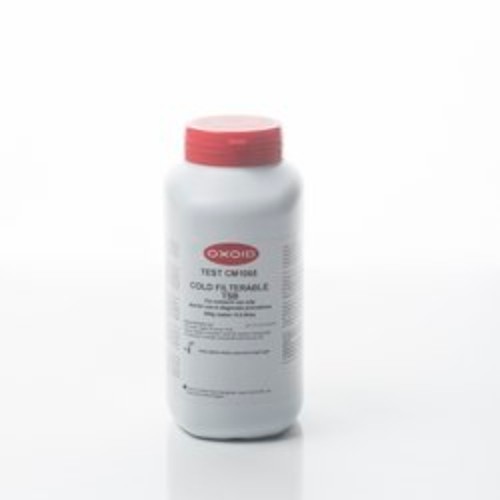
Baird-Parker Agar (ISO) 500g
Login to see pricesBrand:
Thermo ScientificTM OxoidTM
Isolate, enumerate, and identify coagulase positive Staphylococcus aureus in food samples with selective Thermo Scientific™ Oxoid™ Baird Parker Agar (ISO) Base (Dehydrated) while adhering to ISO 6888-1:1999.
Baird Parker Agar (ISO) Base, Oxoid Composition
| Typical Formula* | gm / litre |
| Pancreatic digest of casein | 10.0 |
| Meat extract | 5.0 |
| Yeast extract | 1.0 |
| Sodium pyruvate | 10.0 |
| L-glycine | 12.0 |
| Lithium chloride | 5.0 |
| Agar | 20.0 |
| pH 7.2 ± 0.2 @ 25°C |
Baird Parker Agar (ISO) Base, Oxoid Preparation:
Suspend 63g of Baird-Parker Agar (ISO) Base in 1,000ml of distilled water. Boil to dissolve the medium and sterilise by autoclaving at 121°C for 15 minutes. Cool to 47°C and aseptically add 50ml of Egg Yolk Tellurite Emulsion (SR0054). Mix well and pour into sterile Petri dishes.
Storage conditions and Shelf life
Store the dehydrated medium at 10-30°C and use before the expiry date on the label.
The prepared medium is best used freshly prepared, but may be suitable for longer storage following in-house validation.
Precautions
Atypical colonies have the same size as typical colonies but can be shining black with or without a narrow white edge; the clear zone or opacity halo can also be absent or barely visible. Grey colonies, free of clear zone, can also be regarded as atypical.
Regard all typical and atypical colonies as coagulase-positive staphylococci irrespective of negative reactions on the medium and carry out further tests.
Colonies of some contaminating organisms growing in close proximity to the coagulase positive colonies may partially digest the coagulase halo reaction.

Cronobacter Screening Broth (CSB)
Login to see pricesBrand:
Thermo ScientificTM OxoidTM
- Oxoid Cronobacter Screening Broth Base (CSB) is a selective enrichment broth for isolation of Cronobacter spp, from food and environmental samples.
- Requires Vancomycin Supplement, 5mg, Part No. SR0247E.
Cronobacter Screening Broth Base (CSB), Oxoid Composition
| Typical Formula* |
gm/litre |
| Peptone |
10.0 |
| Meat extract |
3.0 |
| Sodium chloride |
5.0 |
| Bromocresol purple |
40 mg |
| Sucrose |
10.0 |
| pH 7.4 ± 0.2 @ 25°C |
Cronobacter Screening Broth (CSB), Oxoid Preparation:
Dissolve 14.02g in 500ml of distilled water. Sterilize by autoclaving at 121°C for 15 minutes. Cool to approximately 50°C, and aseptically add the contents of 1 vial of Vancomycin Supplement (5mg) (SR0247E) reconstituted as directed. Mix well and aseptically dispense into sterile containers.
Storage conditions and Shelf life
Store the dehydrated medium at 10-30°C and use before the expiry date on the label
Store the prepared medium at 2-8°C

Alkaline Peptone Water (ISO) 500g
Login to see pricesBrand:
Thermo ScientificTM OxoidTM
Enrich and recover Vibrio species from food and water samples with Thermo Scientific™ Oxoid™ Alkaline Saline Peptone Water (ISO) (Dehydrated), while adhering to ISO/TS 21872-1&2:2007. This medium is selective by exploiting the ability of Vibrio species to tolerate alkaline conditions and high sodium chloride levels. The peptone content provides the conditions for growth and recovery of Vibrio species, supplying vitamins, minerals, and nitrogen in the form of amino acids.
Alkaline Saline Peptone Water (ISO), Oxoid Composition
| Typical Formula * |
gm/litre
|
| Peptone |
20.0 |
| Sodium chloride |
20.0 |
| pH 6.6 ± 0.2 @ 25°C |
Alkaline Saline Peptone Water (ISO), Oxoid Preparation:
Dissolve 40g in 1 litre of distilled water. Mix well and distribute into final containers. Sterilize by autoclaving at 121°C for 15 minutes.
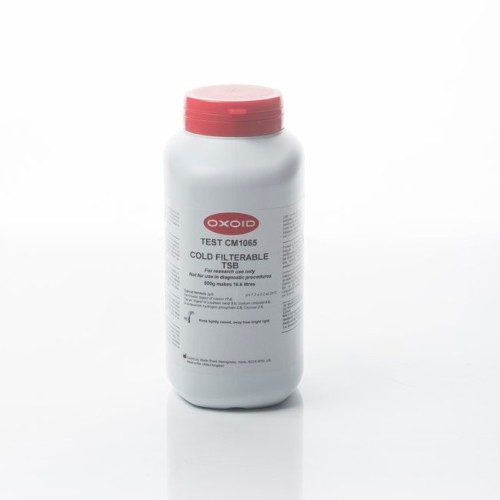
Enterobacteria Broth-Mossel (EP/USP/JP/BP) 500g
Login to see pricesBrand:
Thermo ScientificTM OxoidTM
Selectively enrich bile tolerant Gram-negative bacteria during microbiological examination of pharmaceutical products with Thermo Scientific™ Oxoid™ Enterobacteria Enrichment Broth-Mossel (EP/USP/JP/BP).
Enterobacteria Enrichment Broth-Mossel (EP/USP/JP/BP), Oxoid Composition
| Typical Formula |
gm/litre |
| Pancreatic digest of gelatine |
10.0 |
| Glucose anhydrous |
4.5 |
| Bile Salts (Sodium desoxycholate, Sodium lauryl sulphate, Sodium citrate) |
3.055 |
| Potassium dihydrogen phosphate |
2.0 |
| Disodium hydrogen phosphate anhydrous |
6.4 |
| Brilliant green |
0.015 |
| pH 7.2 ± 0.2 @ 25°C |
Enterobacteria Enrichment Broth-Mossel (EP/USP/JP/BP), Oxoid Preparation:
Dissolve 25.97g in 1 litre of purified water. Mix well and distribute 100ml into 250ml flasks. Heat the medium at 100°C using free flowing steam for 30 minutes only. Cool rapidly in cold running water.
DO NOT AUTOCLAVE.
Storage conditions and Shelf life
Store the dehydrated medium at 10-30°C and use before the expiry date on the label.
Store the prepared medium at 2-25°C.

MSRV (ISO) 500g
Login to see pricesBrand:
Thermo ScientificTM OxoidTM
Selectively enrich Salmonella spp. from food, animal feces, and environmental samples with Thermo Scientific™ Oxoid™ Modified Semi-solid Rappaport Vassiliadis (MRSV) Agar (ISO) (Dehydrated). The efficacy of the medium is based upon the ability of Salmonellae to migrate through the selective medium ahead of competing Gram-negative, motile organisms and, thus, produce opaque halos of growth.
Modified Semi-solid Rappaport Vassiliadis (MRSV) Agar (ISO), Oxoid Composition
| Typical Formula* |
gm/ litre |
| Enzymatic digest of animal and plant tissue |
4.6 |
| Acid hydrolysate of casein |
4.6 |
| Sodium chloride |
7.3 |
| Potassium dihydrogenphosphate (KH2PO4) |
1.5 |
| Magnesium chloride anhydrous (MgCl2) |
10.9 |
| Malachite green oxalate |
0.04 |
| Agar |
2.7 |
| pH 5.2 (5.1 to 5.4) @ 25°C |
MSRV (ISO) Agar, Oxoid Preparation:
Suspend 31.6g of MSRV (ISO) Agar base in 1 litre of distilled water. Bring to the boil with frequent agitation. DO NOT AUTOCLAVE. Cool to 50°C, and aseptically add the contents of 1 vial of Novobiocin Supplement (SR0181), reconstituted as directed. Mix well, and pour into sterile Petri dishes. This medium is semi-solid, therefore do not invert plates.
Storage conditions and Shelf life
MSRV (ISO) should be stored in the tightly capped original container at 10-30°C. Novobiocin Supplement should be stored in the dark at 2-8°C. When stored as directed, the un-opened products will remain stable until the expiry date printed on the packaging.
Precautions
MSRV (ISO) Agar is for laboratory use only. Do not use the dehydrated medium beyond the stated expiry date or if the product shows any sign of deterioration.
Basal medium is very hygroscopic.
When handling powder a face mask and gloves must be worn. Refer to material safety data sheet for details.

24 Leb Base 500g
Login to see pricesBrand:
Thermo ScientificTM OxoidTM
Selectively enrich Listeria monocytogenes and other Listeria spp. from food and environmental samples with Thermo Scientific™ Oxoid™ 24 Listeria Enrichment Broth (24 LEB) (Dehydrated). The medium provides optimal growing conditions for all Listeria species for PCR applications. It is specifically designed for use with PCR systems, such as Thermo Scientific™ SureTect™ molecular assays for Listeria.
24 LISTERIA ENRICHMENT BROTH (24 LEB), Oxoid Composition
| Typical Formula * |
gm/litre
|
| Peptone |
23.4 |
| Yeast extract |
5.0 |
| Lithium chloride |
10.0 |
| Ferric ammonium citrate |
0.1 |
| Sodium chloride |
5.0 |
| pH 7.4 ± 0.2 @ 25°C |
24 LISTERIA ENRICHMENT BROTH (24 LEB), Oxoid Preparation:
Completely dissolve 21.75g of 24 LEB Base per 500ml of distilled water. Sterilize by autoclaving at 121°C for 15 minutes. Cool to 50°C. Aseptically add the contents of 1 vial of 24 LEB Selective Supplement per 500ml medium, reconstituted as directed. Cool to room temperature before use, and, once made, store the medium at 2-8°C in the dark.
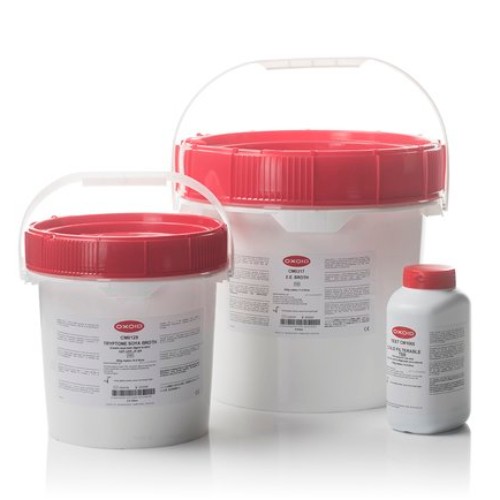
Brilliance UTI Clarity Agar 500g
Login to see pricesBrand:
Thermo ScientificTM OxoidTM
Easily isolate, enumerate, and presumptively identify common organisms associated with urinary tract infections using Thermo Scientific™ Brilliance™ UTI Clarity™ Agar. Organisms are differentiated through the utilization of two chromogenic substrates and/or tryptophan.
Brilliance UTI Clarity Agar, Oxoid Composition
| Typical Formula* |
gm/ litre |
| Peptone |
9.00 |
| Chromogenic Mix |
17.00 |
| Tryptophan |
1.00 |
| Agar |
10.00 |
| pH 7.0 ± 0.2 @ 25ºC |
Brilliance UTI Clarity Agar, Oxoid Preparation:
To prepare the medium from the base, suspend 37g of Brilliance UTI Clarity Agar (CM1106) in 1 litre of distilled water. Mix well and sterilize by autoclaving at 121ºC for 15 minutes. Cool the medium to 50ºC and pour into sterile Petri dishes.
Storage conditions and Stability
Dehydrated Brilliance UTI Clarity Agar must be stored tightly capped in the original container at 10-30ºC.
Oxoid Brilliance UTI Clarity Agar plates should be stored in the original packaging, at the temperature stated on the pack or product specification, and protected from direct light.
When stored as directed, the unopened product will remain stable until the expiry date on the label. Locally prepared media can be stored for up to 2 weeks when made from CM1106 according to the manufacturer’s instructions and stored at 2-8ºC, out of direct sunlight. A longer shelf life may be attainable, but should be validated under the relevant, local manufacturing and storage conditions.
Precautions
Brilliance UTI Clarity Agar is for in vitro diagnostic use only, by experienced microbiologists. It must not be used beyond the stated expiry date, or if the product shows any sign of deterioration.
It should be noted that, as with all chromogenic media, organisms with atypical enzyme patterns may give anomalous reactions. The medium should be validated with locally prevalent strains to confirm sensitivity and specificity in the end-users hands, under local conditions.
A presumptive E. coli identification can be confirmed using DMAC indole reagent (do not use Kovac’s reagent as the colour of the pink colonies may be mistaken for the red colour of a positive indole result). The test should be performed on filter paper, not directly on the plate.
Sterilise specimens, equipment and media properly after use.
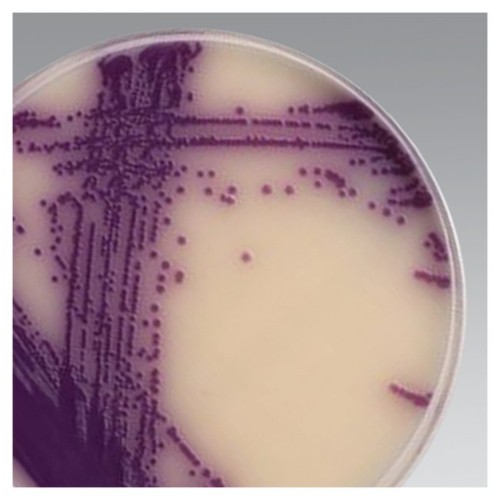
Brilliance Salmonella Agar Base 500g
Login to see pricesBrand:
Thermo ScientificTM OxoidTM
Thermo Scientific™ Brilliance Salmonella Agar Base is a chromogenic medium (formerly OSCM II) for isolation and presumptive identification of Salmonella spp. from food samples.
Brilliance Salmonella Agar Base, Oxoid Composition
| Typical Formula* |
gm/ litre |
| Inhibigen™ mix |
14 |
| Chromogenic Mix |
25 |
| Agar |
15 |
| pH 7.3 ± 0.1 @ 25ºC |
Brilliance Salmonella Agar, Oxoid Preparation:
Suspend 27g of Brilliance Salmonella Agar Base in 500ml of distilled water. Add the contents of 1 vial of Salmonella Selective Supplement, resuspended as directed. Mix well and sterilise by bringing to the boil with frequent agitation. Cool to around 50ºC, mix well and pour into sterile Petri dishes.
NOTE: It is critical that the selective supplement is added prior to heating. When preparing volumes greater than 1 litre contact Oxoid Technical Support for directions.
Storage conditions and Shelf life
Brilliance Salmonella Agar should be stored in the tightly capped original container at 10-30ºC. When stored as directed, the un-opened products will remain stable until the expiry date printed on the packaging.
Precautions
Brilliance Salmonella Agar is for in vitro diagnostic use only, by experienced microbiologists. It must not be used beyond the stated expiry date, or if the product shows any sign of deterioration.
Sterilise specimens, equipment and media properly after use.
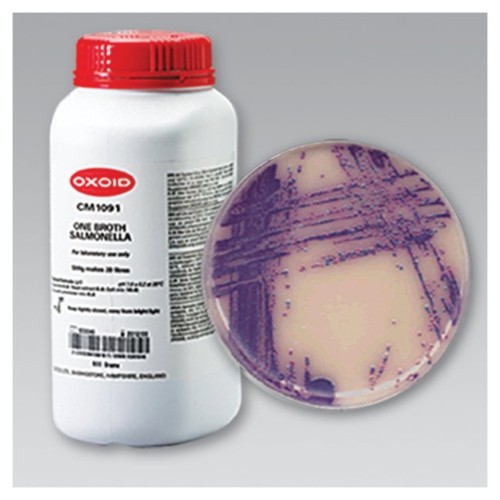
One Broth-Salmonella 500g
Login to see pricesBrand:
Thermo ScientificTM OxoidTM
Enrich and recover Salmonella spp. from food samples in a single step with Thermo Scientific™ Oxoid™ ONE Broth-Salmonella Base, when prepared with Thermo Scientific Oxoid ONE Broth-Salmonella Selective Supplement (SR0242).
ONE Broth-Salmonella Base, Oxoid Composition
| Typical Formula* |
gm/ litre |
| Peptone |
5 |
| Yeast extract |
5 |
| Salt buffer mix |
10 |
| Growth promoter mix |
5 |
| pH 7.0† ± 0.2 at 25ºC |
ONE Broth-Salmonella Base, Oxoid Preparation:
Suspend 5.6g of ONE Broth-Salmonella Base in 225ml of distilled water. Sterilize by autoclaving at 121°C for 15 minutes. Cool to below 50°C and add the contents of 1 vial of ONE Broth-Salmonella Supplement (SR0242), resuspended as directed.
Storage conditions and Shelf life
ONE Broth-Salmonella should be stored tightly capped in the original container at 10-30ºC. When stored as directed, the unopened products will remain stable until the expiry date printed on the packaging.
Once prepared, ONE Broth-Salmonella can be stored for up to 2 weeks when made from CM1091 and SR0242 according to the manufacturer’s instructions and stored at 2-8ºC, in the dark. A longer shelf life may be attainable, but should be validated under the relevant, local manufacturing and storage conditions.
Precautions
ONE Broth-Salmonella medium and Brilliance Salmonella Agar are for in vitro diagnostic use only, by experienced microbiologists. It must not be used beyond the stated expiry date, or if the product shows any sign of deterioration. Sterilize specimens, equipment and media properly after use; dispose waste in accordance with local rules and regulations. Directions should be read and followed carefully.
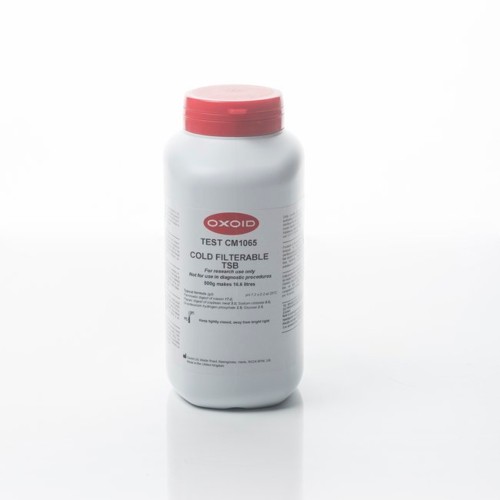
Chromogenic Listeria Agar Base (ISO) 500g
Login to see pricesBrand:
Thermo ScientificTM OxoidTM
This product has been discontinued, please refer to CM1212B
Isolate, enumerate and differentiate Listeria species and Listeria monocytogenes from food samples with Thermo Scientific™ Oxoid™ Chromogenic Listeria Agar (ISO) (Dehydrated). Chromogenic Listeria Agar (ISO) contains lithium chloride, polymyxin B, nalidixic acid, and amphotericin which act to inhibit non-target organisms. A combination of chromogenic and phospholipase enzyme reactions easily differentiate Listeria monocytogenes (blue colonies surrounded by an opaque halo) from other Listeria spp. (blue colonies without an opaque halo).
Chromogenic Listeria Agar (ISO), Oxoid Composition
| Typical Formula* |
gm/litre |
| Enzymatic digest of animal tissues |
18.0
|
| Enzymatic digest of casein |
6.0
|
| Sodium pyruvate |
2.0
|
| Glucose |
2.0
|
| Magnesium glycerophosphate |
1.0
|
| Magnesium sulphate (anhydrous) |
0.5
|
| Sodium chloride |
5.0
|
| Yeast extract |
10.0
|
| Lithium chloride |
10.0
|
| Disodium hydrogen phosphate (anhydrous) |
2.5
|
| X-glucoside chromogenic mix |
0.05
|
| Agar |
12.0 |
| Final pH 7.2 ± 0.2 @ 25°C |
Modified ISO Preparation:
Suspend 34.5g of Chromogenic Listeria Agar (ISO) in 480ml of distilled water. Mix well and sterilize by autoclaving at 121°C for 15 minutes. Cool the medium to 46°C and add one vial of Chromogenic Listeria Selective Supplement (ISO), reconstituted as directed and one vial of Brilliance Listeria Differential Supplement. Mix well and pour into sterile Petri dishes.
ISO Preparation:
Suspend 34.5g of Chromogenic Listeria Agar (ISO) Base in 480ml of distilled water. Mix well and sterilise by autoclaving at 121ºC for 15 minutes. Cool the medium to around 50ºC, and add one vial of Chromogenic Listeria Selective Supplement (ISO), re-suspended as directed, and one vial of OCLA (ISO) Differential Supplement. Mix well and pour into sterile Petri dishes.
Storage conditions and Shelf life
The dehydrated medium should be stored at 10-30°C and used before the expiry date on the label.
Prepared medium may be stored for up to 2 weeks at 2-8°C.
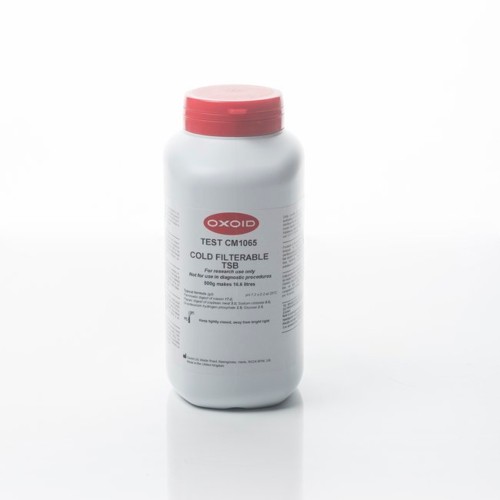
Violet Red Bile Glucose Agar Base (ISO)
Login to see pricesBrand:
Thermo ScientificTM OxoidTM
This item is not available at the moment. Please refer to the alternative, Violet Red Bile Glucose Agar (CM0485B). However, please note that this product does not conform to ISO.
Selectively enumerate Enterobacteriaceae in food, animal feed, and environmental samples with Thermo Scientific™ Oxoid™ Violet Red Bile Glucose (VRBG) Agar (ISO) (Dehydrated) while adhering to ISO 21528 and ISO 11133:2014. Due to the careful addition of selective inhibitory components, neutral red, crystal violet, and bile salts, the medium provides selectivity against non-target Gram-positive bacteria.
Violet Red Bile Glucose (VRBG) Agar (ISO) (Dehydrated), Oxoid Composition
| Typical Formula* |
gm/ litre |
| Enzymatic digest of animal tissues |
7.0 |
| Yeast extract |
3.0 |
| Bile salts No. 3 |
1.5 |
| Sodium chloride |
5.0 |
| Neutral red |
0.03 |
| Crystal violet |
0.002 |
| Glucose |
10.0 |
| Agar |
12.0 |
| pH 7.4 ± 0.2 @ 25°C |
Violet Red Bile Glucose (VRBG) Agar (ISO) (Dehydrated), Oxoid Preparation:
Suspend 38.5g of VRBGA (ISO) dehydrated medium in 1 litre of distilled water. Bring to the boil while mixing. Continue to boil for up to 2 minutes or for the minimum time necessary to dissolve completely. DO NOT AUTOCLAVE. Cool to 44-47°C and use within 4 hours. Mix well before pouring.
Storage conditions and Shelf life
VRBGA (ISO) should be stored in the tightly capped original container at 10-30°C. When stored as directed, the un-opened product will remain stable until the expiry date printed on the packaging.
Locally prepared VRBGA (ISO) plates can be stored for up to 2 weeks when made from CM1082 according to the manufacturer’s instructions and stored at 2-8°C, out of direct sunlight. A longer shelf life may be attainable, but should be validated under the relevant, local manufacturing and storage conditions.
Precautions
VRBGA (ISO) should be prepared, cooled to 44-47°C and used within 4 hours.
VRBGA (ISO) is for laboratory use only. Do not use the dehydrated medium beyond the stated expiry date or if the product shows any sign of deterioration.
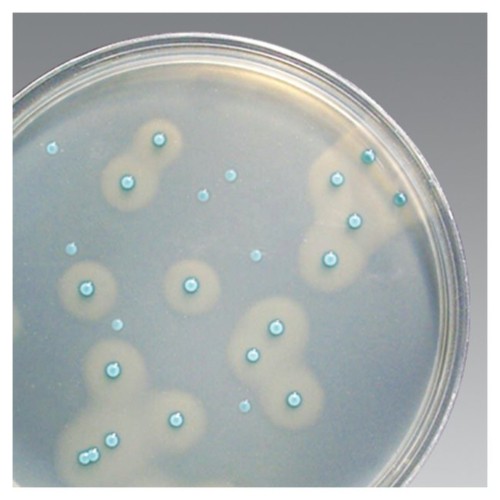
Brilliance™ Listeria Agar Base 500g
Login to see pricesBrand:
Thermo ScientificTM OxoidTM
This product has been discontinued, please refer to CM1212B
Brilliance Listeria Agar Base is a chromogenic medium for the isolation, enumeration, and presumptive identification of Listeria spp., including Listeria monocytogenes. Also available Chromogenic Listeria Selective Supplement, Part No. SR0227E and Chromogenic Listeria Differential Supplement, Part No. SR0228E.
Brilliance Listeria Agar Base, Oxoid Composition
| Typical Formula* |
gm/litre |
| Peptone |
18.5
|
| Yeast extract |
4.0
|
| Sodium chloride |
9.5
|
| Sodium pyruvate |
2.0
|
| Lithium chloride |
15.0
|
| Maltose |
4.0
|
| X-glucoside chromogenic mix |
0.2
|
| Agar |
14.0 |
| pH 7.2 ± 0.2 @ 25°C |
Brilliance Listeria Agar, Oxoid Preparation:
Suspend 33.6g of Brilliance Listeria Agar Base (CM1080) in 480ml of distilled water. Mix well and sterilize by autoclaving at 121°C for 15 minutes. Cool the medium to 46°C and add one vial of Brilliance Listeria Selective Supplement, reconstituted as directed and one vial of Brilliance Listeria Differential Supplement. Mix well and pour into sterile Petri dishes.
Storage conditions and Shelf life
The dehydrated medium should be stored at 10-30°C and used before the expiry date on the label.
Prepared medium may be stored for up to 2 weeks at 2-8°C.

One Broth Base – Listeria 500g
Login to see pricesBrand:
Thermo ScientificTM OxoidTM
Detect and enumerate Escherichia coli and other coliforms in food and water samples with selective, chromogenic Thermo Scientific™ Brilliance™ E. coli / Coliform Selective Agar. The agar base uses two chromogens to differentiate between E. coli and other coliforms. This results in purple E. coli, as they are able to cleave both chromogens while other coliforms, giving pink colonies.
ONE Broth-Listeria Base, Oxoid Composition
| Typical Formula* |
gm/litre |
| Peptone |
28.0
|
| Carbohydrate mix |
6.0
|
| Salt mix |
10.0
|
| Final pH 7.4 ± 0.2 @ 25°C |
ONE Broth-Listeria, Oxoid Preparation:
Suspend 22g of ONE Broth-Listeria Base in 500ml (44g/l) of distilled water. Mix well and sterilize by autoclaving at 121°C for 15 minutes. Cool the medium to below 50°C and aseptically add the contents of one vial of ONE Broth-Listeria Selective Supplement (SR0234) reconstituted as directed.
Storage conditions and Shelf life
ONE Broth-Listeria Base must be stored tightly capped in the original container at 10-30°C.
Store the prepared medium for up to 4 weeks at 2-8°C.
Precautions
ONE Broth-Listeria Base and ONE Broth Selective Supplement are for Laboratory Use Only.
ONE Broth-Listeria Base is designated as “Irritant” and ONE Broth-Listeria Selective Supplement is designated as “Harmful”. For a full Material Safety Data Sheet (MSDS).
Do not use ONE Broth-Listeria Base or ONE Broth-Listeria Selective Supplement beyond the stated expiry dates, or if the products show any sign of deterioration.
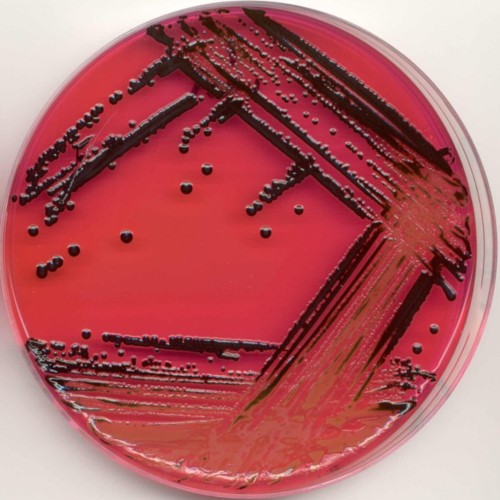
XLT-4 Agar 500g
Login to see pricesBrand:
Thermo ScientificTM OxoidTM
Efficiently isolate and identify salmonellae from clinical, environmental and food samples with highly selective Thermo Scientific™ XLT-4 Agar. XLT-4 Agar contains sodium tetradecylsulfate which acts to inhibit many of the background flora organisms whose growth can cause problems with differentiation on other Salmonellae plating media. This enhanced selectivity allows a significant increase in the recovery of salmonellae, while reducing false-positive suspect colonies, saving time and reducing the costs of further identification of false-positive colonies.
XLT-4 Agar Base, Oxoid Composition
| Typical Formula* |
gm/litre |
| Proteose Peptone |
1.6
|
| Yeast extract |
3.0
|
| Lysine |
5.0
|
| Xylose |
3.75
|
| Lactose |
7.5
|
| Sucrose |
7.5
|
| Ferric ammonium citrate |
0.8
|
| Sodium thiosulphate |
6.8
|
| Sodium chloride |
5.0
|
| Phenol Red |
0.08
|
| Agar |
18.0 |
| Final pH 7.4 ± 0.2 @ 25°C |
XLT-4 Agar, Oxoid Preparation:
Suspend 59g of XLT-4 Agar Base in 1 litre of distilled water, add 4.6ml of XLT-4 Selective Supplement and bring the medium to the boil.
Do not overheat, do not autoclave.
Cool to approximately 50°C and pour into sterile Petri dishes. It is not advised to hold the medium at 50°C for longer than 1 hour as this may cause the medium to precipitate.
Storage conditions and Shelf life
The dehydrated medium should be stored at 10-30°C and used before the expiry date on the label.
Prepared medium may be stored for up to 2 weeks at 2-8°C.

Brilliance Cronobacter Sakazakii Agar (DFI) 500g
Login to see pricesBrand:
Thermo ScientificTM OxoidTM
Differentiate and enumerate Cronobacter sakazakii from infant formula and other food samples with Thermo Scientific™ Brilliance™ Cronobacter Sakazakii Agar (Dehydrated). A chromogenic substrate present in the medium detects a-glucosidase reaction in Cronobacter sakazakii. The enzyme a-glucosidase, present in Cronobacter sakazakii, hydrolyses the substrate producing blue-green colonies on this pale yellow medium.
Brilliance Cronobacter Sakazakii Agar, Oxoid Composition
| Typical Formula * |
gm/litre |
| Tryptone |
15.0
|
| Soya peptone |
5.0
|
| Sodium chloride |
5.0
|
| Ferric ammonium citrate |
1.0
|
| Sodium desoxycholate |
1.0
|
| Sodium thiosulphate |
1.0
|
| Chromogen |
0.1
|
| Agar |
15.0 |
| Final pH 7.3 ± 0.2 @ 25°C |
Brilliance Cronobacter Sakazakii Agar, Oxoid Preparation:
Suspend 43.1g of Brilliance Cronobacter sakazakii Agar in 1 litre of distilled water. Mix well and bring to the boil to dissolve completely. Sterilize by autoclaving at 121°C for 15 minutes. Cool the medium to 50°C. Mix well and pour into sterile Petri dishes.
Storage conditions and Shelf life
The dehydrated medium should be stored at 10-30°C and used before the expiry date on the label.
Prepared medium may be stored for up to 2 weeks at 2-8°C.

Buffered Peptone Water (ISO) 500g
Login to see pricesBrand:
Thermo ScientificTM OxoidTM
Pre-enrich food samples prior to the isolation of Salmonella species using Thermo Scientific™ Oxoid™ Buffered Peptone Water (ISO) (Dehydrated). Buffered Peptone Water is a non-selective pre-enrichment medium and is tested in accordance with ISO 6579 and ISO 11133:2014. It also provides conditions for resuscitation of cells that have been injured by processes of food preservation.
Buffered Peptone Water (ISO), Oxoid Composition
| Typical Formula* |
gm/litre |
| Enzymatic digest of casein |
10.0 |
| Sodium chloride |
5.0 |
| Disodium hydrogen phosphate (anhydrous) |
3.5 |
| Potassium dihydrogen phosphate |
1.5
|
| pH 7.0 ± 0.2 @ 25°C |
Buffered Peptone Water (ISO), Oxoid Preparation:
Add 20.0g of Buffered Peptone Water (ISO) to 1 litre of distilled water. Mix well and distribute into final containers. Sterilise by autoclaving at 121°C for 15 minutes.
Method of use
The sample is added to Buffered Peptone Water (ISO) at a ratio of 1:10, and incubated at 36°C ± 2°C for 16-20 hours before transfer to selective enrichment media.
Storage conditions and Shelf life
Store the dehydrated medium at 10-30°C and use before the expiry date on the label.



